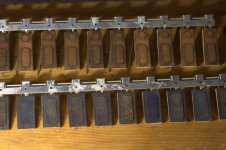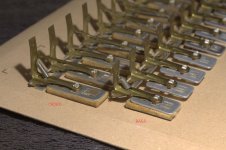I've finally got round to looking at the bass pallets on my 1950s Scandalli LMMH, and it's a tiny bit weird:

Yep, they're very old and very manky, original I'm certain.
The chord pallets (top of image) are also trapezoidal: 14mm wide at the top and 16mm at the bottom. Anybody know why I shouldn't replace those with rectangular facings ?
I'm also wondering what effect pillows that size would have on the bass performance.

Yep, they're very old and very manky, original I'm certain.
The chord pallets (top of image) are also trapezoidal: 14mm wide at the top and 16mm at the bottom. Anybody know why I shouldn't replace those with rectangular facings ?
I'm also wondering what effect pillows that size would have on the bass performance.


